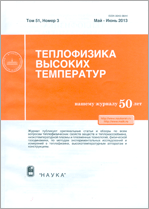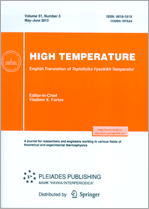|
|
Teplofizika vysokikh temperatur, 2002, Volume 40, Issue 5, Pages 810–825
(Mi tvt1956)
|
 |
|
 |
This article is cited in 1 scientific paper (total in 1 paper)
High Temperature Apparatuses and Structures
Power and Transport Systems for Space Applications, Utilizing the MHD Method of Energy Conversion
V. S. Slavin, V. V. Danilov, I. A. Kuzovatov, K. A. Finnikov, K. Yu. Litvintcev, T. A. Milovidova, A. A. Gavrilov
Krasnoyarsk State Technical University
Abstract:
The possibility of developing power and transport systems for space applications is examined. It is suggested to use an MHD generator utilizing inhomogeneous gas-plasma flows of inert gas as the source of electric energy in such systems. The plasma of the current layers may be in the state of "frozen ionization", when the degree of ionization exceeds the equilibrium level thereby providing for an effective MHD interaction with the enthalpy extraction coefficient of $0.4$ and adiabatic efficiency of $0.8$. Such a plasma is stable with respect to dissipative instabilities (ionization and overheating) and retains its positive properties at a stagnation pressure of the order of $1$ MPa. The estimation of the mass-and-size characteristics of a closed-cycle solar MHD facility for space applications reveals that the specific power of the facility may amount to $500$ W/kg. It is suggested that the propulsion unit should be provided by an electric rocket engine on the basis of an MHD accelerator, with the working medium provided by a nonuniform gas-plasma flow in which azimuthal plasma rings (T-layers) are inductively connected to the electric energy source. In a flow with T-layers, an efflux velocity of the order of $40$ km/s is attained. With a mass flow rate of $50$ g/s, the engine may develop a propulsive force of $2000$ N.
Received: 11.10.2000
Citation:
V. S. Slavin, V. V. Danilov, I. A. Kuzovatov, K. A. Finnikov, K. Yu. Litvintcev, T. A. Milovidova, A. A. Gavrilov, “Power and Transport Systems for Space Applications, Utilizing the MHD Method of Energy Conversion”, TVT, 40:5 (2002), 810–825; High Temperature, 40:5 (2002), 754–768
Linking options:
https://www.mathnet.ru/eng/tvt1956 https://www.mathnet.ru/eng/tvt/v40/i5/p810
|


| Statistics & downloads: |
| Abstract page: | 290 | | Full-text PDF : | 226 |
|





 Contact us:
Contact us: Terms of Use
Terms of Use
 Registration to the website
Registration to the website Logotypes
Logotypes








 Citation in format
Citation in format 
